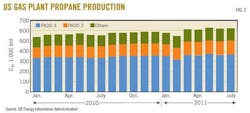P. 3 ~ Continued - US PROPANE — MIDYEAR 2011: US propane trade undergoes historic changes; more likely
View Article as Single page
Gas plants
EIA statistics indicate that gas plant propane production averaged 614,000 b/d for second-quarter 2011. Production in second quarter is typically higher than in first quarter and second-quarter 2011 was no exception. Production increased by 35,600 b/d from first quarter to second quarter.
Gas plant production in second-quarter 2011 was also 52,600 b/d more than year-earlier volumes. Gas plant production was slightly lower in third-quarter 2011 and averaged 605,000-610,000 b/d. Production was about 41,000 b/d higher than in 2010.
US gas plant production for second and third quarters 2011 was also 105,000-110,000 b/d (19.7 million bbl) more than the average for 2006-08 and development of NGL-rich gas in Texas ensures continued growth in supply. The historic transition from gas plant production at its steady levels of 2001-08 to the current growth trend began in 2009.
We forecast gas plant production will average 590,000-610,000 b/d during fourth-quarter 2011 and first-quarter 2012. Before 2010, US gas plant production was consistently lower than its historic peak in 2001 and historians will point to 2009-10 as the turning point to a sustained uptrend in domestic production.
Fig. 2 shows trends in propane production from gas plants.
Refineries
For second-quarter 2011, EIA statistics showed propane production from refineries (net of propylene for propylene chemicals markets) averaged 274,000 b/d and was 13,000 b/d higher than net refinery supply in first-quarter 2011. For third-quarter 2011 (based on EIA statistics for July and estimates for August and September), refinery-propane production was again 270,000-275,000 b/d.
We forecast purity propane supply from refineries will average 275,000-280,000 b/d for fourth-quarter 2011 and 255,000-265,000 b/d for first-quarter 2012. Fig. 3 shows trends in total propane production (gas plants and refineries).
Consistent with the seasonal decline in retail propane sales, propane imports from Canada typically average 65,000-75,000 b/d during second and third quarters. Additionally, East Coast terminals usually continue to receive shipments from international sources during second and third quarter but at reduced volumes, compared with imports during winter. |
Imports
Based on data for second-quarter 2011 published by the Foreign Trade Division of the US Census Bureau, total imports averaged 82,200 b/d and imports from Canada averaged 62,500 b/d. Total imports were equal to year-earlier volumes.
Imports from Canada during second-quarter 2011 were 6,600 b/d lower than year-earlier volumes. East Coast import terminals also received 19,700 b/d of waterborne imports during second-quarter 2011, or 6,500 b/d more than year-earlier volumes.
In third-quarter 2011, we estimate total imports averaged 70,000-80,000 b/d. Canada accounted for 60,000-65,000 b/d and various international sources provided 10,000-15,000 b/d of waterborne imports through East Coast import terminals. Imports from Canada were about 5,000 b/d lower in third-quarter 2011 than in 2010, but waterborne imports into East Coast terminals were 10,000-15,000 b/d higher than in 2010.
We forecast Canadian shipments to the US will average 120,000-130,000 b/d in fourth-quarter 2011 and first-quarter 2012. We note 2009-10 also marked a turning point in Canadian supply for the winter heating season. Before winter 2009-10, US markets could count on Canadian shipments of 135,000-175,000 b/d. The beginning of sustained growth in US natural gas production had the counterbalancing impact of reduced Canadian gas exports and, consequently, reduced gas-plant propane production, especially in Alberta.
Finally, we forecast waterborne imports (limited to East Coast terminals only) will average 30,000-40,000 b/d for fourth-quarter 2011 and 35,000-45,000 b/d for first-quarter 2012. Total imports will average 155,000-165,000 b/d for fourth-quarter 2011 and 165,000-175,000 b/d for first-quarter 2012. Total imports for winter 2011-12 will be about the same as the previous winter heating season.
Displaying 3/6
View Article as Single page


